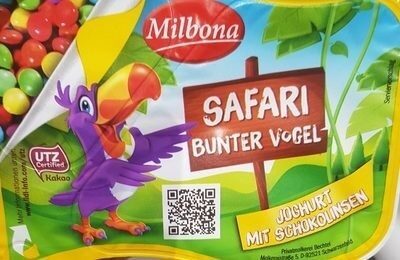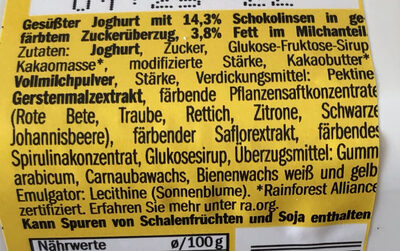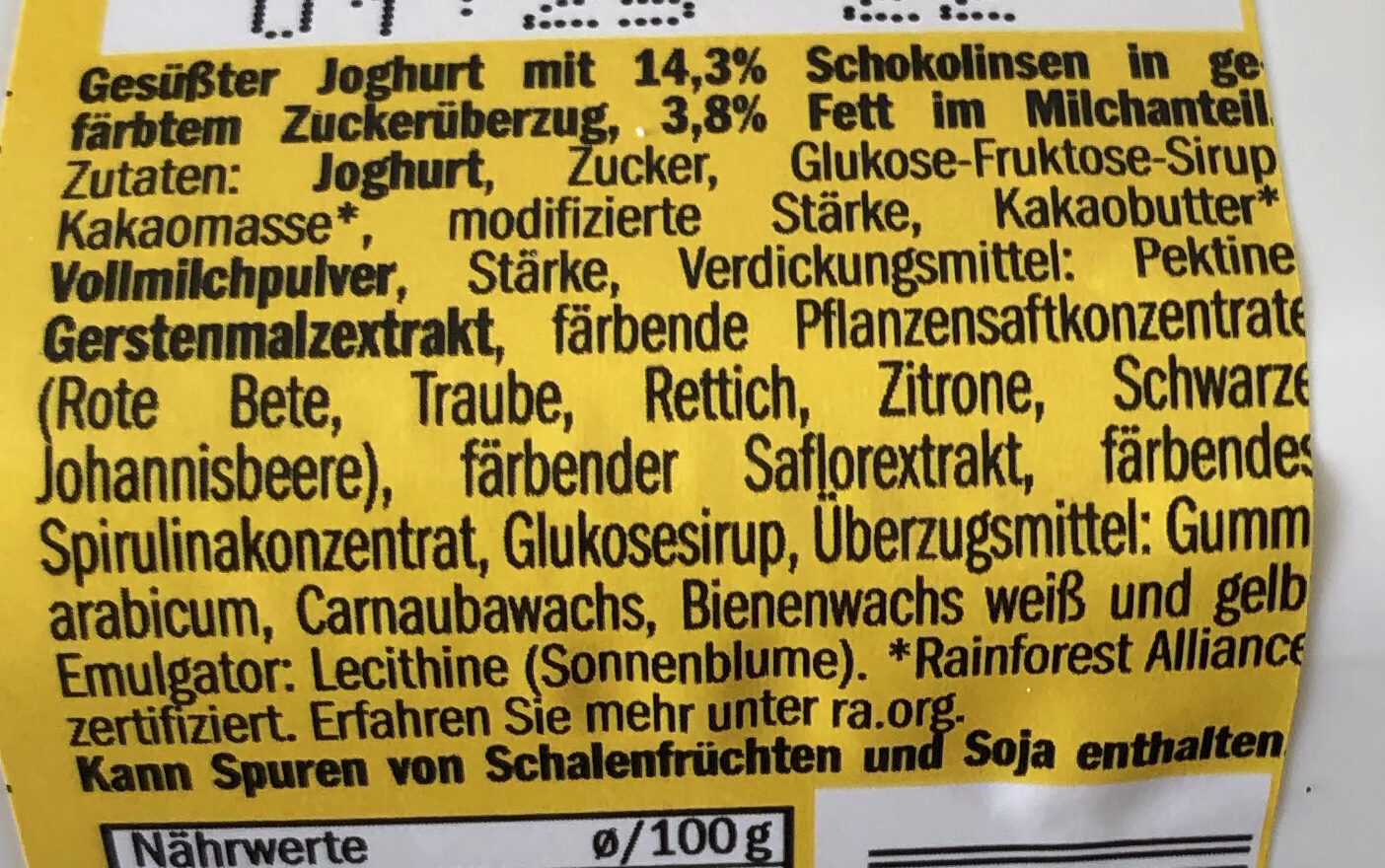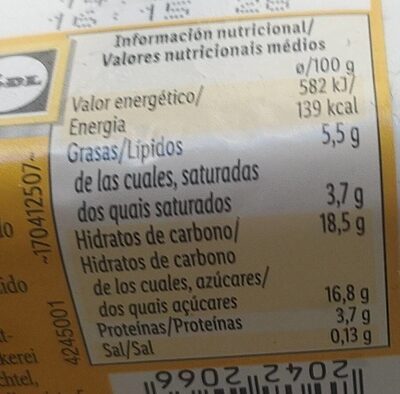Help us make food transparency the norm!
As a non-profit organization, we depend on your donations to continue informing consumers around the world about what they eat.
The food revolution starts with you!
Bunter Vogel - Milbona - 175 g
Bunter Vogel - Milbona - 175 g
Ambiguous barcode: This product has a Restricted Circulation Number barcode for products within a company. This means that different producers and stores can use the same barcode for different products.
×
This product page is not complete. You can help to complete it by editing it and adding more data from the photos we have, or by taking more photos using the app for Android or iPhone/iPad. Thank you!
×
Barra-kodea: 20422066
Kopurua: 175 g
Ontziratzea: en:Plastic
Markak: Milbona
Kategoriak: Esneki, en:Fermented foods, en:Fermented milk products, en:Desserts, en:Dairy desserts, en:Fermented dairy desserts, Jogurt
Etiketak, ziurtagiriak, sariak:
en:Sustainable farming, UTZ Certified, es:Con Lacasitos
Link to the product page on the official site of the producer: http://www.lidl-info.com/utz
Dendak: Lidl
Matching with your preferences
Health
Osagaiak
-
25 ingredients
Aleman: Joghurt, Zucker, Glucose-Fruktose-Sirup, Kakaomasse, Vollmilchpulver, Stärke, Verdickungsmittel: Pektine, Gerstenmalzextrakt, färbende Pflanzensaftkonzentrate (Rote Bete, Traube, Rettich, Zitrone, Schwarze Johannisbeere), färbender Saflorextrakt, färbendes Spirulinakonzentrat, Glukosesirup, Überzugsmittel: Gummi arabicum, Carnaubawachs, Bienenwachs weiß und gelb, Emulgator: Lecithine (Sonnenblume)Alergenoak: en:Gluten, en:Milk
Food processing
-
Ultra processed foods
Elements that indicate the product is in the 4 - Ultra prozesatutako elikagaiak eta edariak group:
- Gehigarria: E322
- Gehigarria: E414
- Gehigarria: E440 - Pektina
- Gehigarria: E901 - Erle-argizari
- Gehigarria: E903
- Osagaia: Emulsifier
- Osagaia: Glazing agent
- Osagaia: Glukosa
- Osagaia: Almibar
- Osagaia: Thickener
Food products are classified into 4 groups according to their degree of processing:
- Prozesatu gabeko edo ahalik eta gutxien prozesatutako elikagaiak
- Sukaldaritzako osagaiak prozesatu
- Prozesatutako jakiak
- Ultra processed foods
The determination of the group is based on the category of the product and on the ingredients it contains.
Gehigarriak
-
E322
Lecithin: Lecithin -UK: , US: , from the Greek lekithos, "egg yolk"- is a generic term to designate any group of yellow-brownish fatty substances occurring in animal and plant tissues, which are amphiphilic – they attract both water and fatty substances -and so are both hydrophilic and lipophilic-, and are used for smoothing food textures, dissolving powders -emulsifying-, homogenizing liquid mixtures, and repelling sticking materials.Lecithins are mixtures of glycerophospholipids including phosphatidylcholine, phosphatidylethanolamine, phosphatidylinositol, phosphatidylserine, and phosphatidic acid.Lecithin was first isolated in 1845 by the French chemist and pharmacist Theodore Gobley. In 1850, he named the phosphatidylcholine lécithine. Gobley originally isolated lecithin from egg yolk—λέκιθος lekithos is "egg yolk" in Ancient Greek—and established the complete chemical formula of phosphatidylcholine in 1874; in between, he had demonstrated the presence of lecithin in a variety of biological matters, including venous blood, in human lungs, bile, human brain tissue, fish eggs, fish roe, and chicken and sheep brain. Lecithin can easily be extracted chemically using solvents such as hexane, ethanol, acetone, petroleum ether, benzene, etc., or extraction can be done mechanically. It is usually available from sources such as soybeans, eggs, milk, marine sources, rapeseed, cottonseed, and sunflower. It has low solubility in water, but is an excellent emulsifier. In aqueous solution, its phospholipids can form either liposomes, bilayer sheets, micelles, or lamellar structures, depending on hydration and temperature. This results in a type of surfactant that usually is classified as amphipathic. Lecithin is sold as a food additive and dietary supplement. In cooking, it is sometimes used as an emulsifier and to prevent sticking, for example in nonstick cooking spray.Source: Wikipedia (Ingeles)
-
E414
Gum arabic: Gum arabic, also known as acacia gum, arabic gum, gum acacia, acacia, Senegal gum and Indian gum, and by other names, is a natural gum consisting of the hardened sap of various species of the acacia tree. Originally, gum arabic was collected from Acacia nilotica which was called the "gum arabic tree"; in the present day, gum arabic is collected from acacia species, predominantly Acacia senegal and Vachellia -Acacia- seyal; the term "gum arabic" does not indicate a particular botanical source. In a few cases so‐called "gum arabic" may not even have been collected from Acacia species, but may originate from Combretum, Albizia or some other genus. Producers harvest the gum commercially from wild trees, mostly in Sudan -80%- and throughout the Sahel, from Senegal to Somalia—though it is historically cultivated in Arabia and West Asia. Gum arabic is a complex mixture of glycoproteins and polysaccharides. It is the original source of the sugars arabinose and ribose, both of which were first discovered and isolated from it, and are named after it. Gum arabic is soluble in water. It is edible, and used primarily in the food industry as a stabilizer, with EU E number E414. Gum arabic is a key ingredient in traditional lithography and is used in printing, paint production, glue, cosmetics and various industrial applications, including viscosity control in inks and in textile industries, though less expensive materials compete with it for many of these roles. While gum arabic is now produced throughout the African Sahel, it is still harvested and used in the Middle East.Source: Wikipedia (Ingeles)
-
E440 - Pektina
Pectin: Pectin -from Ancient Greek: πηκτικός pēktikós, "congealed, curdled"- is a structural heteropolysaccharide contained in the primary cell walls of terrestrial plants. It was first isolated and described in 1825 by Henri Braconnot. It is produced commercially as a white to light brown powder, mainly extracted from citrus fruits, and is used in food as a gelling agent, particularly in jams and jellies. It is also used in dessert fillings, medicines, sweets, as a stabilizer in fruit juices and milk drinks, and as a source of dietary fiber.Source: Wikipedia (Ingeles)
-
E901 - Erle-argizari
Beeswax: Beeswax -cera alba- is a natural wax produced by honey bees of the genus Apis. The wax is formed into "scales" by eight wax-producing glands in the abdominal segments of worker bees, which discard it in or at the hive. The hive workers collect and use it to form cells for honey storage and larval and pupal protection within the beehive. Chemically, beeswax consists mainly of esters of fatty acids and various long-chain alcohols. Beeswax has long-standing applications in human food and flavoring. For example, it is used as a glazing agent or as a light/heat source. It is edible, in the sense of having similar negligible toxicity to plant waxes, and is approved for food use in most countries and the European Union under the E number E901. However, the wax monoesters in beeswax are poorly hydrolysed in the guts of humans and other mammals, so they have insignificant nutritional value. Some birds, such as honeyguides, can digest beeswax. Beeswax is the main diet of wax moth larvae.Source: Wikipedia (Ingeles)
-
E903
Carnauba wax: Carnauba -; Portuguese: carnaúba [kaʁnɐˈubɐ]-, also called Brazil wax and palm wax, is a wax of the leaves of the palm Copernicia prunifera -Synonym: Copernicia cerifera-, a plant native to and grown only in the northeastern Brazilian states of Piauí, Ceará, Maranhão, Bahia, and Rio Grande do Norte. It is known as "queen of waxes" and in its pure state, usually comes in the form of hard yellow-brown flakes. It is obtained from the leaves of the carnauba palm by collecting and drying them, beating them to loosen the wax, then refining and bleaching the wax.Source: Wikipedia (Ingeles)
Ingredients analysis
-
en:Palm oil free
No ingredients containing palm oil detected
Unrecognized ingredients: de:färbende-pflanzensaftkonzentrate, de:färbender-saflorextrakt, de:färbendes-spirulinakonzentratSome ingredients could not be recognized.
We need your help!
You can help us recognize more ingredients and better analyze the list of ingredients for this product and others:
- Edit this product page to correct spelling mistakes in the ingredients list, and/or to remove ingredients in other languages and sentences that are not related to the ingredients.
- Add new entries, synonyms or translations to our multilingual lists of ingredients, ingredient processing methods, and labels.
If you would like to help, join the #ingredients channel on our Slack discussion space and/or learn about ingredients analysis on our wiki. Thank you!
-
en:Non-vegan
Non-vegan ingredients: en:Yogurt, en:Whole milk powder, E901Some ingredients could not be recognized.
We need your help!
You can help us recognize more ingredients and better analyze the list of ingredients for this product and others:
- Edit this product page to correct spelling mistakes in the ingredients list, and/or to remove ingredients in other languages and sentences that are not related to the ingredients.
- Add new entries, synonyms or translations to our multilingual lists of ingredients, ingredient processing methods, and labels.
If you would like to help, join the #ingredients channel on our Slack discussion space and/or learn about ingredients analysis on our wiki. Thank you!
-
en:Vegetarian status unknown
Unrecognized ingredients: de:färbende-pflanzensaftkonzentrate, de:färbender-saflorextrakt, de:färbendes-spirulinakonzentratSome ingredients could not be recognized.
We need your help!
You can help us recognize more ingredients and better analyze the list of ingredients for this product and others:
- Edit this product page to correct spelling mistakes in the ingredients list, and/or to remove ingredients in other languages and sentences that are not related to the ingredients.
- Add new entries, synonyms or translations to our multilingual lists of ingredients, ingredient processing methods, and labels.
If you would like to help, join the #ingredients channel on our Slack discussion space and/or learn about ingredients analysis on our wiki. Thank you!
-
Details of the analysis of the ingredients
We need your help!
Some ingredients could not be recognized.
We need your help!
You can help us recognize more ingredients and better analyze the list of ingredients for this product and others:
- Edit this product page to correct spelling mistakes in the ingredients list, and/or to remove ingredients in other languages and sentences that are not related to the ingredients.
- Add new entries, synonyms or translations to our multilingual lists of ingredients, ingredient processing methods, and labels.
If you would like to help, join the #ingredients channel on our Slack discussion space and/or learn about ingredients analysis on our wiki. Thank you!
de: Joghurt, Zucker, Glucose-Fruktose-Sirup, Kakaomasse, Vollmilchpulver, Stärke, Verdickungsmittel (Pektine), Gerstenmalzextrakt, färbende Pflanzensaftkonzentrate (Rote Bete, Traube, Rettich, Zitrone, Schwarze Johannisbeere), färbender Saflorextrakt, färbendes Spirulinakonzentrat, Glukosesirup, Überzugsmittel (Gummi arabicum), Carnaubawachs, Bienenwachs weiß und gelb, Emulgator (Lecithine (Sonnenblume))- Joghurt -> en:yogurt - vegan: no - vegetarian: yes - ciqual_proxy_food_code: 19593 - percent_min: 6.25 - percent_max: 100
- Zucker -> en:sugar - vegan: yes - vegetarian: yes - ciqual_proxy_food_code: 31016 - percent_min: 0 - percent_max: 16.8
- Glucose-Fruktose-Sirup -> en:glucose-fructose-syrup - vegan: yes - vegetarian: yes - ciqual_food_code: 31077 - percent_min: 0 - percent_max: 16.8
- Kakaomasse -> en:cocoa-paste - vegan: yes - vegetarian: yes - ciqual_proxy_food_code: 16030 - percent_min: 0 - percent_max: 16.8
- Vollmilchpulver -> en:whole-milk-powder - vegan: no - vegetarian: yes - ciqual_food_code: 19021 - percent_min: 0 - percent_max: 16.8
- Stärke -> en:starch - vegan: yes - vegetarian: yes - ciqual_proxy_food_code: 9510 - percent_min: 0 - percent_max: 16.6666666666667
- Verdickungsmittel -> en:thickener - percent_min: 0 - percent_max: 14.2857142857143
- Pektine -> en:e440a - vegan: yes - vegetarian: yes - percent_min: 0 - percent_max: 14.2857142857143
- Gerstenmalzextrakt -> en:barley-malt-extract - vegan: yes - vegetarian: yes - percent_min: 0 - percent_max: 12.5
- färbende Pflanzensaftkonzentrate -> de:färbende-pflanzensaftkonzentrate - percent_min: 0 - percent_max: 11.1111111111111
- Rote Bete -> en:beetroot - vegan: yes - vegetarian: yes - ciqual_proxy_food_code: 20091 - percent_min: 0 - percent_max: 11.1111111111111
- Traube -> en:grape - vegan: yes - vegetarian: yes - ciqual_food_code: 13112 - percent_min: 0 - percent_max: 5.55555555555556
- Rettich -> en:radish - vegan: yes - vegetarian: yes - ciqual_food_code: 20045 - percent_min: 0 - percent_max: 3.7037037037037
- Zitrone -> en:lemon - vegan: yes - vegetarian: yes - ciqual_proxy_food_code: 13009 - percent_min: 0 - percent_max: 2.77777777777778
- Schwarze Johannisbeere -> en:blackcurrant - vegan: yes - vegetarian: yes - ciqual_food_code: 13007 - percent_min: 0 - percent_max: 2.22222222222222
- färbender Saflorextrakt -> de:färbender-saflorextrakt - percent_min: 0 - percent_max: 10
- färbendes Spirulinakonzentrat -> de:färbendes-spirulinakonzentrat - percent_min: 0 - percent_max: 9.09090909090909
- Glukosesirup -> en:glucose-syrup - vegan: yes - vegetarian: yes - ciqual_proxy_food_code: 31016 - percent_min: 0 - percent_max: 8.33333333333333
- Überzugsmittel -> en:glazing-agent - percent_min: 0 - percent_max: 7.69230769230769
- Gummi arabicum -> en:e414 - vegan: yes - vegetarian: yes - percent_min: 0 - percent_max: 7.69230769230769
- Carnaubawachs -> en:e903 - vegan: yes - vegetarian: yes - percent_min: 0 - percent_max: 7.14285714285714
- Bienenwachs weiß und gelb -> en:e901 - vegan: no - vegetarian: yes - percent_min: 0 - percent_max: 6.66666666666667
- Emulgator -> en:emulsifier - percent_min: 0 - percent_max: 6.25
- Lecithine -> en:e322 - vegan: maybe - vegetarian: maybe - percent_min: 0 - percent_max: 6.25
- Sonnenblume -> en:sunflower - vegan: yes - vegetarian: yes - percent_min: 0 - percent_max: 6.25
- Lecithine -> en:e322 - vegan: maybe - vegetarian: maybe - percent_min: 0 - percent_max: 6.25
Elikadura
-
Average nutritional quality
⚠ ️Abisua: zuntz kopurua ez dago zehaztuta, ezin izan dute kontuan izan kalifikaziorako izan dezaketen ekarpen positiboa.⚠ ️Warning: the amount of fruits, vegetables and nuts is not specified on the label, it was estimated from the list of ingredients: 0This product is not considered a beverage for the calculation of the Nutri-Score.
Positive points: 2
- Proteinak: 2 / 5 (balioa: 3.79, rounded value: 3.79)
- Fiber: 0 / 5 (balioa: 0, rounded value: 0)
- Fruits, vegetables, nuts, and colza/walnut/olive oils: 0 / 5 (balioa: 0.829687499999999, rounded value: 0.8)
Negative points: 7
- Energia: 1 / 10 (balioa: 599, rounded value: 599)
- Azukreak: 3 / 10 (balioa: 16.8, rounded value: 16.8)
- Gantz saturatua: 3 / 10 (balioa: 3.7, rounded value: 3.7)
- Sodioa: 0 / 10 (balioa: 52, rounded value: 52)
The points for proteins are counted because the negative points are less than 11.
Nutritional score: (7 - 2)
Nutri-Score:
-
Nutrient levels
-
Koipe in moderate quantity (5.5%)
What you need to know- A high consumption of fat, especially saturated fats, can raise cholesterol, which increases the risk of heart diseases.
Recommendation: Limit the consumption of fat and saturated fat- Choose products with lower fat and saturated fat content.
-
Gantz-azido ase in moderate quantity (3.7%)
What you need to know- A high consumption of fat, especially saturated fats, can raise cholesterol, which increases the risk of heart diseases.
Recommendation: Limit the consumption of fat and saturated fat- Choose products with lower fat and saturated fat content.
-
Azukre in high quantity (16.8%)
What you need to know- A high consumption of sugar can cause weight gain and tooth decay. It also augments the risk of type 2 diabetes and cardio-vascular diseases.
Recommendation: Limit the consumption of sugar and sugary drinks- Sugary drinks (such as sodas, fruit beverages, and fruit juices and nectars) should be limited as much as possible (no more than 1 glass a day).
- Choose products with lower sugar content and reduce the consumption of products with added sugars.
-
Gatz arrunt in low quantity (0.13%)
What you need to know- A high consumption of salt (or sodium) can cause raised blood pressure, which can increase the risk of heart disease and stroke.
- Many people who have high blood pressure do not know it, as there are often no symptoms.
- Most people consume too much salt (on average 9 to 12 grams per day), around twice the recommended maximum level of intake.
Recommendation: Limit the consumption of salt and salted food- Reduce the quantity of salt used when cooking, and don't salt again at the table.
- Limit the consumption of salty snacks and choose products with lower salt content.
-
-
Nutrition facts
Nutrition facts As sold
for 100 g / 100 mlCompared to: Jogurt Energia 599 kj
(139 kcal)+% 78 Koipe 5,5 g +% 104 Gantz-azido ase 3,7 g +% 118 Carbohydrates 18,5 g +% 93 Azukre 16,8 g +% 87 Fiber ? Proteina 3,79 g +% 3 Gatz arrunt 0,13 g +% 5 Fruits‚ vegetables‚ nuts and rapeseed‚ walnut and olive oils (estimate from ingredients list analysis) 0,83 %
Ingurumena
-
Eco-Score B - Ingurumen-eragin txikia
The Eco-Score is an experimental score that summarizes the environmental impacts of food products.→ The Eco-Score was initially developped for France and it is being extended to other European countries. The Eco-Score formula is subject to change as it is regularly improved to make it more precise and better suited to each country.Life cycle analysis
-
Average impact of products of the same category: A (Score: 87/100)
Kategoria: Yogurt, fermented milk or dairy specialty, plain
Kategoria: Yogurt, fermented milk or dairy specialty, plain
- PEF environmental score: 0.22 (the lower the score, the lower the impact)
- including impact on climate change: 2.12 kg CO2 eq/kg of product
Stage Impact Agriculture
67.6 %Processing
13.5 %Ontziratzea
6.8 %Transportation
7.0 %Distribution
4.0 %Consumption
1.1 %
Bonuses and maluses
-
Missing origins of ingredients information
Malus: -5
⚠ ️ The origins of the ingredients of this product are not indicated.
If they are indicated on the packaging, you can modify the product sheet and add them.
If you are the manufacturer of this product, you can send us the information with our free platform for producers.
-
Packaging with a medium impact
Malus: -10
Shape Material Recycling Impact Unknown Plastic Altua ⚠ ️ The information about the packaging of this product is not sufficiently precise (exact shapes and materials of all components of the packaging).⚠ ️ For a more precise calculation of the Eco-Score, you can modify the product page and add them.
If you are the manufacturer of this product, you can send us the information with our free platform for producers.
Eco-Score for this product
-
Impact for this product: B (Score: 79/100)
Produktua: Bunter Vogel - Milbona - 175 g
Life cycle analysis score: 87
Sum of bonuses and maluses: -5
Final score: 79/100 (The score of products with non-recyclable and non-biodegradable packaging materials is capped at 79 (grade B).)
-
Carbon footprint
-
Equal to driving 1.1 km in a petrol car
212 g CO² per 100g of product
The carbon emission figure comes from ADEME's Agribalyse database, for the category: Yogurt, fermented milk or dairy specialty, plain (Source: ADEME Agribalyse Database)
Stage Impact Agriculture
72.9 %Processing
7.1 %Ontziratzea
8.5 %Transportation
9.5 %Distribution
1.7 %Consumption
0.3 %
Ontziratzea
-
Packaging with a medium impact
-
Packaging parts
(Plastic)
-
Bilgarriaren materialak
Material % Bilgarriaren pisua Bilgarriaren pisua produktuaren 100g-ko Plastic
-
Transportation
-
Origins of ingredients
Missing origins of ingredients information
⚠ ️ The origins of the ingredients of this product are not indicated.
If they are indicated on the packaging, you can modify the product sheet and add them.
If you are the manufacturer of this product, you can send us the information with our free platform for producers.Add the origins of ingredients for this product Add the origins of ingredients for this product
Etiketak
Report a problem
-
Incomplete or incorrect information?
Category, labels, ingredients, allergens, nutritional information, photos etc.
If the information does not match the information on the packaging, please complete or correct it. Open Food Facts is a collaborative database, and every contribution is useful for all.
Datuen iturria
Product added on by kiliweb
Last edit of product page on by fix-serving-size-bot.
Produktuaren orria -gatik editatua date-limite-app, elcoco, livlakaemper, olibnk, openfoodfacts-contributors, packbot, roboto-app, tacite, tacite-mass-editor, teolemon, thaialagata, yuka.V0k4ak1JUVFqNlVGeXNBNSt4L1k0ZDFKbXA2SVhGUHFFY1ZNSUE9PQ, yuka.VktVRklKVWJpY1FubHZkbHBrdlYyODV1d3JXQ1dHYStlN0JJSVE9PQ, yuka.sY2b0xO6T85zoF3NwEKvlhVrTNz-rQvpFzj4sECQ--nSK7P4a_xL4tnlKKs.












